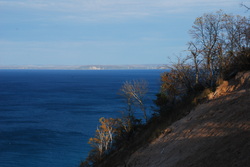
It's hard to believe that Fall Break happened over a week ago - with midterms, problem sets, and the poster session, time has been flying by here at SPH. Thankfully, Fall Break this year was actually a break (last year all of the midterms were after the break, so it was more of a "break from class so you won't be distracted while you study" type of a vacation), so I figured that I'd use the time to go explore Michigan. The area around Ann Arbor is nice - lots of rivers, streams, and lakes - but I'd never seen the northern half of Michigan and so decided to camp at Sleeping Bear Dunes for a few days. The weather was perfect - high 60s and sunny - and since it was the middle of the Fall, the campsites were fairly empty (at least we didn't have to contend with lots of loud RVs at night). We also managed to hit that point right before the leaves drop off the trees, so the drive north to Traverse City (only about 4 hours) had lots of nice scenery along the way. The camping was different than I'm used to (there was actually running water and permanent toilets!), so "roughing it" isn't really an apt description of the facilities. The park has lots of nice trails that wander through the dunes, and it's easy to forget that you're standing on sand that was dropped here at the end of last ice age when you're walking through the middle of a forest. Once you make it through the dunes, the views out over Lake Michigan and across to the Manitou Islands are great. There's even a dune climb where you can hike up the hills for a bit and over to the lakeshore (although running down on the trip back is more fun...).  This trip was my first time seeing one of the Great Lakes, and it was weird to see waves in something that didn't have a salt spray. The more I explore Michigan, the more I come to like the state - it's much different than I had expected when I moved here, and there's lots of state parks and forests to explore. All in all, the trip up north was a great way to escape school and homework for a few days, and it's inspired me to plan a trip to the Upper Peninsula sometime next year - after the snows melt, of course.
3 Comments
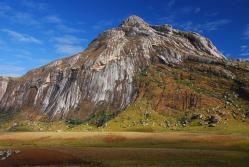 After climbing Mt. Mulanje over the weekend I no longer doubt that Chichewa has 13 words for "mud" and none for "switchback." Mulanje is not a typical mountain - it's more of a giant granite mesa that juts up from the surrounding tea estates. There are over 76 peaks on top of this plateau, but getting up to the plateau requires more than a bit of effort and covering almost 2,000 vertical feet in less than 2 miles. Just when you think you're doing well, your porters will pass you literally running up the mountain in bare feet (or if they feel the need to protect themselves, flip-flops). 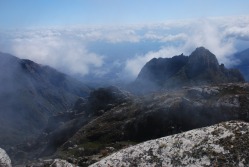 Once you finish the climb (after stopping every 20 minutes or so to catch your breath and enjoy the view out into Mozambique) you find yourself on a large plateau with some gently rolling hills. The landscape shares a strange affinity with some areas of Scotland, and this effect was heightened by the misty weather that rolled in every afternoon (we managed to visit during a chiperonde, which is a fancy word for cold, wet air blowing in from Mozambique that settles over Southern Malawi for days at a time). The mountain itself is an interesting place - local legend maintains that it is home to evil spirits (the name of the highest peak, Sapitwa, translates to "Don't go there.") and there are no permanent settlements on the plateau, but there are large tracts of Mulanje Cedar that the forestry department allows the locals to harvest. 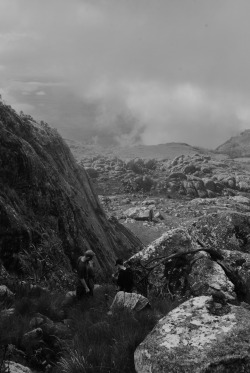 We camped overnight in a hut which thankfully had a nice fireplace (temperatures dropped to below freezing soon after the sun went down) and woke up early the next morning to climb Namasile (pictured at the top), the second highest peak on the massif (and therefore in all of Malawi). The trail up the peak followed a stream bed over some rolling hills for about 30 minutes until we began the ascent - another hour of fairly uneventful steep slopes. Then we lost the trail. It happened at a large boulder that was totally overgrown with moss and trees (a very Indiana Jones-esque moment, especially when we found leopard scat in the cave we eventually had to crawl through). Apart from this small detour, the rest of the climb was uneventful and we made it to the summit just as the clouds rolled in and obscured our view of just about everything. Interestingly, the first thing our guide did was to bang a rock against a metal sign to scare the spirits away (although he claimed later that the myths were all lies told to impress the visiting white people). We made it down fairly quickly, camped overnight again, and then started down the plateau the next morning, which was certainly easier than it was going up. Once we made it down, we drove around the mountain and had lunch at, of all things, a Malawian-run Italian restaurant. Pizza and beer have never tasted so good.
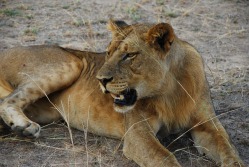 Malawi has odd visa requirements - you can stay in the country continuously for up to 3 months without any problems, but if you stay longer than 3 months than you must enter a nightmarish world of bureaucracy, fines, and paperwork to obtain a 6-month permit. However, if you leave the country after three months and re-enter, you can stay for another 3 with no problems. One of my housemates found himself in this situation, so we decided to resolve the problem in the only reasonable manner: by going on safari. Malawi has a few game parks and national preserves, but none compare to South Luangwa National Park in Zambia. Getting there was a bit of a challenge - 4 hours by bus to Lilongwe, then a 6-hour car transfer from Lilongwe (Malawi) to Mfuwe (Zambia), the last 3-hours of which are on an insanely bumpy and dusty road, and finally on to the park (after a two-hour stop at the border, the particulars of which still confuse me). 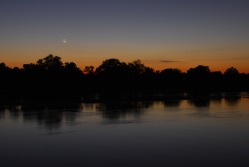 We arrived in camp around dusk, greeted by Moses (our guide) with the words "Do you want to see a crocodile?" (the answer is always yes). Disoriented from the ride, we walked about 25 feet and came to the riverbank, where we could see crocs and hippos about 10 yards away from us. After this introduction we had a brief speech about safety (don't walk alone at night; too many hippos and elephants - I thought they were joking but when I was woken up at 3AM by an elephant not three feet from my tent it became clear that that might actually be a Good Idea) and then it was off to dinner. Safaris start early (animals don't wait for people) and we hit the road at 6AM (wake-up call at 5AM) for our first trip into the bush. Honestly, I wasn't expecting much and told myself that I would be happy with seeing a few elephants, some grazers, and maybe a hippo, zebra, or giraffe. I was wrong. Within an hour we had found two lions and a herd of zebra, and before the drive was over we'd also seen 12 elephants and ambushed a herd of giraffes. The night drive (4PM to 8PM) was even better - it started off by watching a pride of lions stalk an impala (they failed), and then driving to within 2 feet of the pride, where the male proceeded to mate with the females (which they told is quite rare). Video (which is funnier than it should be) will be on YouTube soon. As night fell, we focused on the one animal that we hadn't seen - a leopard. Although South Luangwa is one of the best places to see them, our guides warned us that we probably wouldn't get so lucky this time around. They were wrong - not only did we find a leopard with 15 minutes, we saw and helped it stalk an impala by using our car to provide cover. Stalking takes a long time, so we switched off the lights and sat in the dark for 15 minutes, listening to the impala bark at each other. We suddenly heard an impala bark much louder and then hooves running away, but when we switched the light back on we saw that the leopard had missed. 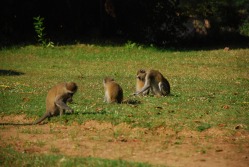 The camp at which we stayed was an adventure in itself - although we slept in tents, they had permanent beds and there were so few people that we each had a tent to ourselves so I'd hesitate to call it camping. Monkeys and baboons ran around the grounds at will, and woe be unto him who left food unattended for more than a few minutes (the monkeys are tricky devils). At night, hippos and elephants began their invasion, and you could count on waking up at least once a night thanks to nearby hippos, who are surprisingly fast out of the water.
The second day was just as exciting as the first - we saw more elephant herds, giraffes fighting, hippos eating, and a fantastic sunset over the river. We even managed to spot yet another leopard, although we only followed this one for a few minutes. After two days of safari, it was back to Blantyre, but South Luangwa is certainly a place I'd love to visit again. 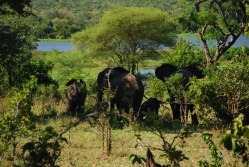 Blantyre is not the world's most exciting town. The city consists of a small downtown area with some shops, restaurants, and a moderate commercial district (one to two banks) surrounded by suburbs, with a small shopping center located near the hospital. Hanging around for the weekend is not exactly the most thrilling way to spend your time. Thankfully, Blantyre is surrounded by great opportunities - there are three mountains that you can climb within 10km of the city proper, and there are no less than 3 game reserves within an hour's drive. These game preserves are off the main tourist track so when we went to visit Majete Wildlife Reserve we had the park to ourselves - we saw one other car for the 6 hours that we were there. Combine the ease of access with the low entrance fee ($20 including gas to and from the park) and it's a perfect place to escape from Blantyre. I didn't expect much from the park - it looked fairly small on the map, but as soon as we drove in my mistake became apparent. The entrance to the park is next to Kapuchiri Falls, which stopped the famous Dr. Livingstone on his first attempt to travel up the Shire River into Malawi. On our way up from the falls we had to stop the car suddenly - 5 elephants chose that moment to cross the road and start grazing about 20 feet away from our car. Violating the first rule of animal safety, I of course got out of the car to take a few pictures (totally worth it) and through dumb luck or the elephants' friendliness I escaped unharmed (although we left the door open in case I should need to sprint back into the car and drive away). 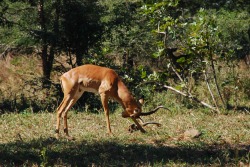 After spotting the elephants we hit a bit of dry spell (not that I'm complaining) were we saw mostly elands, impalas, and sable until reaching the "Hippo Spot", where, true to it's name, about 10 hippos were basking in the sun and sitting in the river. We carried on from this point to a loop around the park (thick underbrush does not a good chance to spot animals make) and were surprised by a massive herd of impala (60-80 strong) leaping across the road with four zebra in pursuit. The impala can jump - their hind legs go above their head and the highest point and it looks like the twisting will either break the back or force them to to tumble down, but they always seemed to land without even breaking stride.
The park was devastated by poaching in the '80s and '90s, but starting in 2006 it has been the focus of an intensive plan to repopulate the park and increase the diversity. They've successfully imported 75 elephants from Liwonde National Park, and the herd now numbers 150. There are supposedly 7 rhinos hiding in the park somewhere, but they are rarely seen. The rangers also plan to introduce lions to the park in 2012, which will be a shock to the complacent population of grazers (I hope all the elands and zebras remember how to run...) but should also bring more visitors to the park. 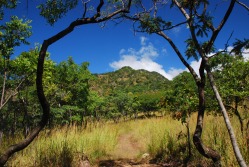 Working at a research institute is not always the most thrilling of pursuits (most of my internship involves staring at computers and working with databases) and it's always nice to escape the office for a while. In Michigan there aren't too many hilly places to go (the worst thing about the Midwest) so I was glad to find mountains all around Blantyre when I arrived in Malawi. Three mountains - Ndirande, Michiru, and Sochi - make a rough triangle around the city, and each one is self-contained nature preserve. Mt. Michiru was our first target, for no other reason than it was the closest and had a mountain to climb (the hint that leopards still lived in the park didn't hurt either). With our goal in mind, we sent off to Mt. Michiru over a less-than-perfectly-maintained road (yay for 4WD!), dodging monkeys and baboons along the way (I may have exaggerated slightly). We went up later on Saturday than planned, and by the time we got there the temperature was a bit high to attempt to climb to the top and decided to take a shorter trail that led over some hyena caves (we didn't see them, but if you stand right on top of one you can smell them - they smelled like wet dog). Other than this non-encounter with hyenas, monkeys were the most exciting wildlife on the hike (our guide was incredulous that we did not have monkeys in the US - in his words "No monkeys? Not even in National Parks!?!"). 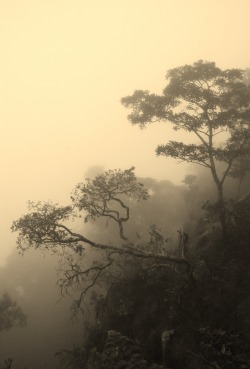 We returned to Mt. Michiru on Sunday and made it to the top this time - unfortunately, the weather was not cooperating and all we could see was the middle of the cloud bank that covered the summit (the picture shows how wonderful the visibility was). Although the mountain was only about 5,000 feet high, Malawi has not yet adopted the switchback - so the trails often go straight up the mountain. The benefit to this approach is that the trails are much shorter, but the downside is that people who are not-so-in-shape (like myself) have a more difficult time of it. Sadly we didn't have any encounters with Large African Mammals, but a group after us was running up the mountain away from a large viper. Since the mountain is easy to get to and has some pretty quick hikes that get you out of the city and into the field I'm sure that I'll be heading back fairly often during my stay.
After nearly 40 hours of continuous travel through three countries, including 3 flights, 2 (long) layovers, and a volcano scare, I've finally made it to Blantyre, Malawi, where I'll be working on my summer internship. Jet-lagged and confused, I landed in Lilongwe, the capital of Malawi, where I met a staff member from the Malaria Alert Center who happened to be in Lilongwe for sample collection and drove me down to Blantyre. The road from Lilongwe to Blantyre was technically a highway, but not what you or I think of as a highway. Highways in Malawi are used by everyone - pedestrians and bicyclists often outnumbered the cars, and as it got darker I began to realize why traffic accidents are a leading cause in sub-Saharan Africa (hint: horns are not always effective at getting a cyclist or pedestrian to scoot over quickly). Most stalls, selling everything from fruit to cell phones to birds on a stick (fun fact: you can buy 5 roasted birds for 100 Kwacha, less than a dollar) set up right along the roadside - there are no real exits or even places to pull over safely off the road. 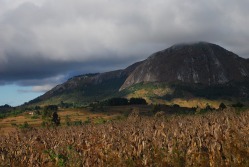 The scenery was amazing. What struck me first is how different everything is - the crows here have a whit torso, but otherwise look like the crows at home and the trees look different, although I can't quite put my finger on why that is. The daily life in Malawi is, obviously, very much not like that in America, and it's easiest to see in how young the population is (most people look to be younger than 25) and by how much work the children have to do. I saw at least 20 kids under the age of 8 herding goats and cattle on the side of the road - one 6-year old was able to herd 20 cattle with just a stick and lots of running. So after the trip, I'm finally settled in to the guesthouse in Blantyre and ready to start my summer internship - I can't wait.
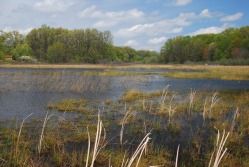 It's hard to believe that I'm halfway done with my MPH - the first year went by too quickly, and the end of the year stress (finals, final projects, etc.) helped it to fly by even more quickly. After finals ended, I noticed something strange - the snow was gone and the weather was gorgeous (lows in the 50's, highs in the mid-70's... while winter is brutal it is hard to dislike MI in the spring). Given the nice new weather, I decided to explore MI a bit with another epidemiology student, and we found two nice hikes that were good escapes from Ann Arbor. One thing that I miss in MI are the hills - I could see mountains from my undergrad and hometown, and when I worked in Germany I was in one of the hillier regions, so MI is oddly flat to me. Since I was used to this terrain, I just assumed that hiking = walking around in hills and mountains, and that hiking around a flat plain wouldn't be all that much fun. Needless to say, I was wrong. We found a bog near Kalamazoo (yes, that's a real place name) and decided that it would make for an interesting adventure, seeing as how I'd never seen a bog before. It was a nice change from the hills and mountain streams that I was used to - all of the plants were different, there were more birds, and there were a few snakes and frogs to keep things interesting. 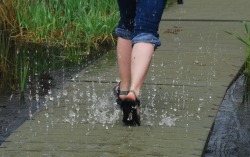 However, the trail was probably the most fun part of the hike. It went right over the bog (I'm not sure how they did it, the plastic boards didn't seem to be anchored to the ground but they were very stable) and if you moved too quickly you could get a bit wet. We didn't expect that the trail would fight back, so the first few steps were a bit wetter than we had anticipated, but after getting adjusting for the surprising squirts it was a nice way to cool off and it always made for a nice surprise. On the way back from Bishop's Bog, we stopped at Bell's Brewery, which has some of Michigan's best local beer and should be a required stop if you find yourself in the area. I'll be heading off to Malawi for my summer internship soon (more on that later), but when I get back to MI I'm looking forward to exploring more of what the state has to offer - especially since I'll only have one more year to take advantage of it.
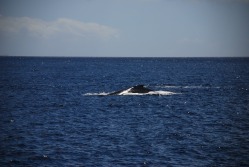 After a few days of lounging on the beach and reading, we decided to explore the island of Maui in a bit more depth (lounging around is nice and all, but I tend to get a bit stir crazy after a few days). I hadn't gotten the chance to go diving in over a year (it seems like a lifetime ago when I was in the water at least twice a day on the weekends) so when I had the opportunity I jumped at the chance. The site of my first dive after the hiatus could not have been better - a shallow reef inside the remains of a volcanic crater. While it was nice to be underwater again (I was surprised at how quickly my buoyancy control came back to me), the clear highlight of the dive was listening to the humpback whales underwater. The crater is shaped like a half-moon, and the hard rock walls amplify and reflect all the sound that comes into it, making it one of the best underwater spots to hear whales singing. And it wasn't just underwater that we found whales - they are everywhere around Maui this time of year, and we saw close to a dozen on the boat ride between the harbor and the dive site. Sadly, none of them breached, but you can't have everything... 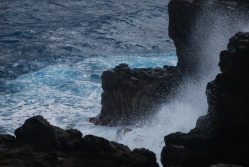 The day after the dive trip (which turned out to be more chaotic than I'd have liked - my dive computer flooded and I almost left my camera on the dive boat...), we found ourselves with access to a rental car, thanks to the arrival of my friend's sister. The weather was not outstanding as we drove around the island (in case the giant crashing seas in what is supposed to be a tropical paradise didn't give that away), but we made the best of it and trekked to blowholes, swimming holes, and the best banana bread stand in the world. Getting to the banana bread stand was the hardest part - although we had to climb over lava rocks to get to the swimming holes, getting to the banana bread stand required a fairly long drive up one-lane cliffside road, with a good amount of traffic moving in both directions. The village that the banana bread was in was worlds apart from the resort complexes that most people think of when they imagine Hawaii - it was a very rural and economically depressed area, and it didn't look like many visitors made it to that part of the island. Sadly, there was one major disappointment of the trip. We woke up at 3AM to go watch the sunrise over a volcanic crater, but the weather conspired against us - after two hours of standing in a cloud/fog bank/something cold and very damp, all that happened when the sun rose was that the cloud turned from black to a lighter shade of dark gray. Inspiring it was not, but now I have a reason to go back. Following the mountain adventure, we headed down to Pa'ia to sit on the beach for one last time, and then it was off to the airport to fly home to Michigan. When I made it back, there was still snow on the ground (which has thankfully since melted). For more pictures, you can check out the gallery here.
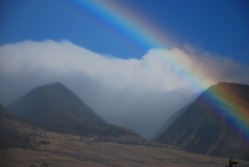 Last Friday, I left 1 1/2 feet of snow on the ground in Ann Arbor and headed to Maui for spring break (it's a rough, rough, life). It was a transition in more ways than one - I was not even close to ready for the 60 degree temperature increase or the fact that I suddenly found myself with the free time to sit down and read a book (4 down so far). The week started off with a somewhat overhyped tsunami warning (all that happened was that we were confined to our hotel for a few hours), but even tsunami warnings are enjoyable in the Aloha state - from the balcony we could see humpback whales breaching in the distance. The scenery is also a nice change from Hawaii - rainforest-covered mountains are a far cry from the flat and snowy midwest. 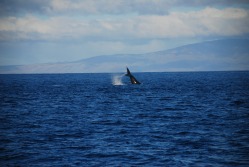 But after a week of lounging, scuba diving, and accidental whale-watching ( humpbacks seem to pop up everywhere here) I'm excited to get back to work. Epidemiology seems to have worked its way into my head and I keep finding odd connections and epidemiologic puzzles, even while on vacation. The best example of this comes from sea turtles, of all places. While snorkeling, we saw a sea turtle that had 5-6 baseball sized tumors on it's neck, flippers, and tail. Curious as to what caused the tumors, I've been asking around but it appears that everyone is stumped (even scuba instructors, normally a source of good info - or at least willing to make something up as long as it's interesting - also didn't have a clue). Like any good scientist, my first thought was to turn to google. After a few minutes of intense digging (it is still vacation, after all) I found this site. From a modest beginning with only a few sightings reported in the 1960's, it is now believed that the disease afflicts more than 60% of Hawaii's green turtles and is sadly often fatal. Although the cause remains unknown, one theory is that the disease is caused by a virus and that it will soon reach epidemic proportions in other sea turtle populations. Now if only I could convince UM SPH to let me study that outbreak...
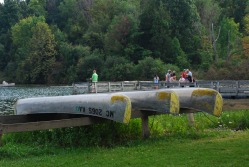 Since classes haven't started yet and my fellow students and I are, for all practical purposes, essentially at summer camp for the next few days, we decided to explore the area around Ann Arbor. Our main requirement was that we find somewhere that we could swim (not as hard as we'd thought, MI is full of lakes) and that it be within an hour's distance. Pickney Park (the name is ridiculous) fit the bill nicely. It's a State Recreation Area about 30 minutes Northwest of Ann Arbor, and contains about a dozen lakes, two of which allow swimming (it's possible in the rest, but these are rather marshy). So off we went, passing some quaint little towns and a pumpkin donut/cider stand (this will warrant further investigation) along the way. The weather cooperated, and at the lake we just hung around, played cards, frisbee (poorly), and soccer (also poorly) - nothing terribly exciting. All in all, it made for a pleasant day and a nice introduction to the area before winter destroys me.
|
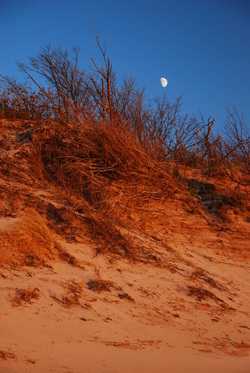
 RSS Feed
RSS Feed